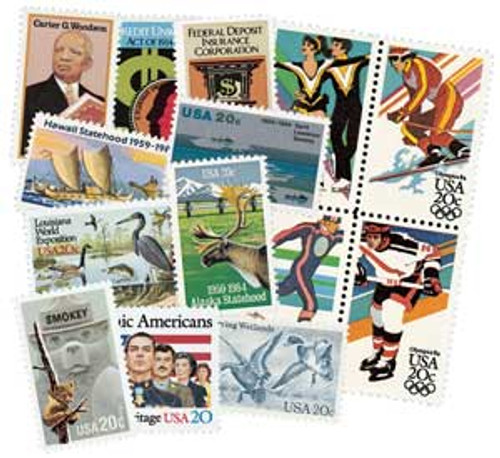
# 2087 - 1984 20c Health Research
U.S. #2087
1984 20¢ Health Research
- Stamp honors health researchers and promotes physical well-being
- First US stamp to include metallic ink (silver border)
Stamp Category: Commemorative
Value: 20¢, rate for first-class mail
First Day of Issue: May 17, 1984
First Day City: New York, New York
Quantity Issued: 120,000,000
Printed by: American Bank Note Company
Printing Method: Photogravure
Format: Panes of 50 in Sheets of 200
Perforations: 11
Why the stamp was issued: To honor those who have contributed to health research and promote the physical well-being of all Americans. It was the 29th stamp in 54 years issued by the US to feature a medical theme.
About the stamp design: This stamp was designed by stamp collector Tyler Smith, who had always wanted to design a postage stamp. He borrowed laboratory equipment from Brown University Medical School, including test tubes, a beaker, a syringe, flasks, and an electronic monitoring machine. Photographer Myron Taylor then photographed an arrangement of the objects in a back-lit light box. Tyler created his stamp art from these photos.
Special design details: This was the first US stamp to include metallic ink – silver – which can be found in the border around the vignette.
First Day City: This stamp was dedicated by USPS medical director Dr. Irvin D. Hermann at the Memorial Sloan-Kettering Cancer Center in New York City.
Unusual fact about this stamp: Examples of this stamp have been found with vertical perforation shifts.
History the stamp represents:
National Institute of Health Promotes Research and Advancements
Congress established the National Board of Health in 1879 to stop the “introduction of contagious or infectious diseases into the United States.” Though only in operation until 1883, this was one of the first instances of the US government officially investing in medical research.
In 1887, New York’s Marine Hospital opened the Hygienic Laboratory with the main focus being the study of bacteria. In the 1920s the organization became Public Health Services and opened a Special Cancer Investigations lab at Harvard Medical School. The lab moved to Washington, DC, in 1891, changed its name to the National Institute of Health (NIH) in 1930, and moved to its present location in Bethesda, Maryland in 1938.
In the years that followed, Congress vastly increased the NIHs funding and created a number of new centers and institutes within it. Over time, 156 Nobel Prize winners received funding from the NIH. Their work led to some groundbreaking inventions and discoveries, including the MRI, understanding how viruses can cause cancer, cholesterol control, using fluoride to prevent tooth decay, how the human brain processes visual information, a treatment for mercury poisoning, the first licensed rubella vaccine, and an effective treatment for Hodgkin’s lymphoma. In the 1990s, the NIH began extensive DNA research, launching the Human Genome Project.
Today the NIH consists of 27 separate institutes and research centers. In 2019 it was ranked #2 in the world for its contributions to biomedical sciences for the large number of published papers.
U.S. #2087
1984 20¢ Health Research
- Stamp honors health researchers and promotes physical well-being
- First US stamp to include metallic ink (silver border)
Stamp Category: Commemorative
Value: 20¢, rate for first-class mail
First Day of Issue: May 17, 1984
First Day City: New York, New York
Quantity Issued: 120,000,000
Printed by: American Bank Note Company
Printing Method: Photogravure
Format: Panes of 50 in Sheets of 200
Perforations: 11
Why the stamp was issued: To honor those who have contributed to health research and promote the physical well-being of all Americans. It was the 29th stamp in 54 years issued by the US to feature a medical theme.
About the stamp design: This stamp was designed by stamp collector Tyler Smith, who had always wanted to design a postage stamp. He borrowed laboratory equipment from Brown University Medical School, including test tubes, a beaker, a syringe, flasks, and an electronic monitoring machine. Photographer Myron Taylor then photographed an arrangement of the objects in a back-lit light box. Tyler created his stamp art from these photos.
Special design details: This was the first US stamp to include metallic ink – silver – which can be found in the border around the vignette.
First Day City: This stamp was dedicated by USPS medical director Dr. Irvin D. Hermann at the Memorial Sloan-Kettering Cancer Center in New York City.
Unusual fact about this stamp: Examples of this stamp have been found with vertical perforation shifts.
History the stamp represents:
National Institute of Health Promotes Research and Advancements
Congress established the National Board of Health in 1879 to stop the “introduction of contagious or infectious diseases into the United States.” Though only in operation until 1883, this was one of the first instances of the US government officially investing in medical research.
In 1887, New York’s Marine Hospital opened the Hygienic Laboratory with the main focus being the study of bacteria. In the 1920s the organization became Public Health Services and opened a Special Cancer Investigations lab at Harvard Medical School. The lab moved to Washington, DC, in 1891, changed its name to the National Institute of Health (NIH) in 1930, and moved to its present location in Bethesda, Maryland in 1938.
In the years that followed, Congress vastly increased the NIHs funding and created a number of new centers and institutes within it. Over time, 156 Nobel Prize winners received funding from the NIH. Their work led to some groundbreaking inventions and discoveries, including the MRI, understanding how viruses can cause cancer, cholesterol control, using fluoride to prevent tooth decay, how the human brain processes visual information, a treatment for mercury poisoning, the first licensed rubella vaccine, and an effective treatment for Hodgkin’s lymphoma. In the 1990s, the NIH began extensive DNA research, launching the Human Genome Project.
Today the NIH consists of 27 separate institutes and research centers. In 2019 it was ranked #2 in the world for its contributions to biomedical sciences for the large number of published papers.









